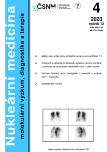-
Medical journals
- Career
Importance of a hybrid lung scintigraphy in patients with emphysema – case report
Authors: O. Lang
Authors‘ workplace: Klinika radiologie a nukleární medicíny, 3. LF UK a FN Královské Vinohrady Praha, Oddělení nukleární medicíny, Oblastní nemocnice Příbram, Oddělení nukleární medicíny, PMCD s. r. o., Praha, ČR 10
Published in: NuklMed 2023;12:72-75
Category: Casuistry
Overview
Introduction: COPD with emphysema is a serious disease which can cause pulmonary hypertension. Clinical symptomatology can mimic symptoms of pulmonary embolism (dyspnea, weakening, hemoptysis). Lung V/Q scintigraphy is an optimal procedure to exclude pulmonary embolism. However, air flow through bronchi is limited so distribution of lung ventilation can be challenged in COPD. Lung ventilation scintigraphy, therefore, can be insufficient for exclusion pulmonary embolism.
Case report: 80-y-old woman was sent to our department to exclude pulmonary embolism. She was a long-lasting smoker; she has a chronic cough during her lifelong being. Patient was examined at internal department for swelling of lower extremities with varicose ulcers. Ultrasonography did not confirm deep venous thrombosis, only dilatation of vena saphena magna with a reflux at the sapheno-femoral junction. CT pulmonary angiography did not confirm pulmonary embolism.
There were quite non-homogenous perfusion of both lungs with a large non-segmental perfusion defects on perfusion scintigraphy; ventilation was completely non-evaluable due to very poor inhalation of 81mKr gas on lung ventilation scintigraphy, so we were not able to exclude pulmonary embolism with certainty. We detected serious parenchymal changes with a significantly reduced density with bulous character on a low dose nondiagnostic CT. So, we can exclude pulmonary embolism and confirm COPD with emphysema as a cause of clinical symptoms.
Conclusion: Hybrid lung scintigraphy in patients with COPD and emphysema is able to explain the cause of dyspnea and simultaneously exclude pulmonary embolism by confirmation of parenchymal changes.
Keywords:
lung scintigraphy – SPECT/CT – Emphysema – COPD
Sources
- Murray CJL, Lopez AD. Evidence-based health policy—lessons from the Global Burden of Disease Study. Science 1996; 274 : 740–743
- Coxson HO, Rogers RM. Quantitative Computed Tomography of Chronic Obstructive Pulmonary Disease. Acad Radiol 2005;12 : 1457–1463
- Coxson HO. Chapter 43 - Quantitative Imaging of the Lung. Editor(s): Barnes PJ, Drazen JM, Rennard SI, Thomson CN. Asthma and COPD: Basic Mechanisms and Clinical Management (Second Edition), Academic Press, 2009, Pages 559-568
- Miniati M, Prediletto R, Formichi B et al. Accuracy of clinical assessment in the diagnosis of pulmonary embolism. Am J Respir Crit Care Med 1999;159 : 864–871
- Bajc M, Neilly JB, Miniati M, et al. EANM guidelines for ventilation/perfusion scintigraphy. Eur J Nucl Med Mol Imaging 2009;36 : 1356–1370
- Invasive and noninvasive diagnosis of pulmonary embolism. Preliminary results of the Prospective Investigative Study of Acute Pulmonary Embolism Diagnosis (PISA-PED). Chest. 1995 Jan;107(1 Suppl):33S-38S. PMID: 7813327.
- Hayhurst MD, Flenley DC, McLean A, et al. Diagnosis of pulmonary emphysema by computerized tomography . Lancet 1984;2 : 320 – 322
- Müller NL, Staples CA, Miller RR, et al“ Density mask ”. An objective method to quantitate emphysema using computed tomography. Chest 1988;94 : 782 – 787
- Lang 0. Perfuzně-ventilační scintigrafie plic s hybridním zobrazením u pacienta s plicní fibrózou – kazuistika. NuklMed 2022;11 : 69-72
Obrazová dokumentace archiv autora.
Labels
Nuclear medicine Radiodiagnostics Radiotherapy
Article was published inNuclear Medicine

2023 Issue 4-
All articles in this issue
- Measurement of the effect of scintillation camera dead time on the quantification of 131I
- Transport capacity of lymphatic system of lower extremities in patients with diabetic foot syndrome – a pilot study
- Importance of a hybrid lung scintigraphy in patients with emphysema – case report
- doc. MUDr. Pavel Koranda, Ph.D.
- Noví členové společnosti
- 59. Dny nukleární medicíny, Ostrava
- Historický kvíz
- Sonda do historie
- Editorial
- Nuclear Medicine
- Journal archive
- Current issue
- Online only
- About the journal
Most read in this issue- Importance of a hybrid lung scintigraphy in patients with emphysema – case report
- Measurement of the effect of scintillation camera dead time on the quantification of 131I
- 59. Dny nukleární medicíny, Ostrava
- Transport capacity of lymphatic system of lower extremities in patients with diabetic foot syndrome – a pilot study
Login#ADS_BOTTOM_SCRIPTS#Forgotten passwordEnter the email address that you registered with. We will send you instructions on how to set a new password.
- Career

